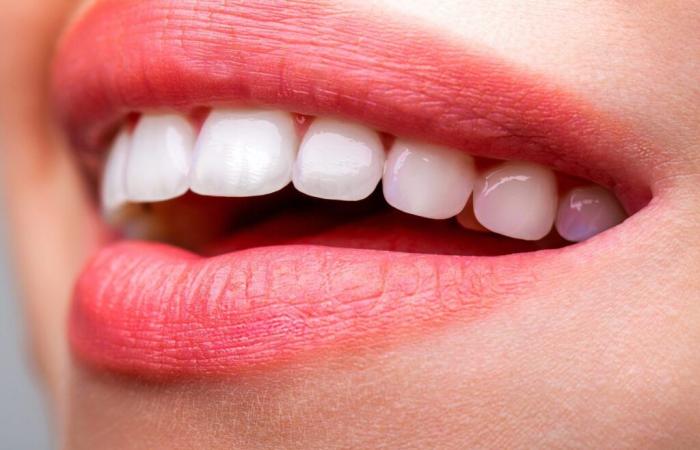Toothpastes are widely used cosmetic and hygienic products. The global toothpaste market is valued at $43 billion, or 6% of the global hygiene and cosmetics market. Health professionals recommend brushing your teeth at least twice a day. It makes toothpaste! In addition, we can say that consumers are spoiled for choice in products: organic, dental sensitivity, healthy gums, anti-tartar… Claims are flourishing. And what is particularly popular are so-called “whitening” toothpastes, which help whiten teeth. 60 million consumers however, warns against these products.
Why try to whiten your teeth?
In our current societies, a dazzling white smile is highly sought after! We actually want to have beautiful, white, stain-free teeth. Many people therefore use methods to whiten their teeth.
The color of teeth changes with age, due to natural wear. The tooth is made up of a specific structure, dentin. It is this which gives it its overall shape. On the outer part of the tooth (the visible part, outside the gum), which is called the crown, the dentin is covered with enamel.
Enamel is a fabric. It is mainly composed of a mineral, hydroxyapatite, collagen and water. It is the hardest tissue in the human body, and is often used in forensic identification of a person.
Dentin and enamel have their specific color. As for dentine, which is also called ivory in other animals, it is yellowish and translucent in color.
Enamel, for its part, has a color that ranges from yellow to light gray. It is also semi-translucent and opalescent, meaning the yellowness of dentin can sometimes show through.
Tooth enamel can become damaged over time. This is particularly the case when the pH of the mouth becomes too acidic, this acidity attacking the enamel. This is called dental erosion. This process is continuous and occurs at any age. Good oral hygiene, including the use of toothpaste, is therefore important to limit its development.
However, this dental erosion can be accelerated by different factors, such as diet (including acidic products), age, poor dental hygiene, etc.
And, the more significant the dental erosion, the less white the teeth will be because the dentin will be seen more and more… Hence the attraction of many people for dental whitening methods, including whitening toothpastes.
>> Also read: Bleeding gums: vitamin c deficiency
How do whitening toothpastes work?
Whitening toothpastes work primarily through a polishing action. This would allow the enamel to regain its natural color after several days or weeks of regular use. They can only act on the color of the enamel. Only professional treatments can affect the color of dentin.
Stains altering the color of the enamel can therefore be removed using substances with abrasive and surfactant properties (detergents for example). The reappearance of these stains can also be limited thanks to anti-tartar molecules.
The substances present in toothpastes often differ depending on the production: organic or conventional. Organic formulations will rather favor hydrated silica, calcium carbonate or vegetable charcoal powder. On the other hand, conventional formulations use abrasive, detergent, anti-scale substances, etc.
No matter what molecules exist, they all promise a dazzling white smile!
Promises that appear on the label, but what is it in reality?
>> Also read: How did we clean our teeth before the invention of toothpaste?
Whitening toothpastes? No, lightening…
Several consumer and health media are issuing alerts regarding the use of these whitening toothpastes. First of all on their effectiveness.
Indeed, oral health professionals make it clear: with toothpaste, no whitening, but rather lightening. A term that should also be used for techniques carried out in dental offices. So be warned: it is impossible to make teeth white! We can just make the enamel brighter and remove the stains.
In addition, the effectiveness of the treatment also depends on the quality of the enamel and its thickness. In fact, the more it erodes, the more transparent it becomes and therefore reveals the color of the dentin.
And precisely, the paradox is that whitening toothpastes, as we have said, act by abrasive action. So, indeed, the more abrasive the toothpaste, the more effective it will be… But ultimately, too effective! And it will damage the enamel, which will reveal the color of the dentin. In the absence of white teeth, we end up with yellowish teeth…
Whitening toothpastes contain several substances, more or less effective.
Crédits : Shutterstock/Willians Labrador
>> Also read: Toothpaste nanoparticles cross the human placenta
Beware of toothpastes that are too abrasive
In theory, we can know the RDA index (Relative Dentin Abrasivity) which indicates the degree of abrasiveness of a toothpaste. However, no regulations require the manufacturer to communicate this.
As a guide, an RDA below 40 corresponds to weak abrasiveness, while an index above 80 corresponds to a rather strong toothpaste. The scale goes from 0 to 250.
60 million consumers tested 12 whitening toothpastes, organic or conventional. They noticed that, regardless of the formulation, they are not very effective. The teeth whitening effect is modest.
The toothpastes tested therefore have a rather low abrasiveness, but at least they do not damage the enamel. Abrasiveness essentially depends on the ingredients used. Bicarbonate was present in half of the toothpastes in the panel and it is rather mild. On the other hand, alumina and activated carbon are fairly strong abrasives.
>> Also read: The secret to impeccable oral hygiene: how many times should you really brush your teeth?
A health hazard?
Toothpastes that are too abrasive, apart from not making teeth so white, can have effects on oral health. If the enamel is too damaged, there is a risk of dental hypersensitivity and cavities.
In addition, certain substances present in toothpastes may pose a health risk. Thus, of the 12 tested by 60 million consumers, only 3 have a Cosméto'Score indicating that they could be used daily without risk to health. The latter is an indicator, explicitly created by the magazine, to decipher the composition of cosmetics, better understand the labels and estimate the potential risks to health and the environment.
60 million consumers have identified several dangerous substances in these whitening toothpastes. There is notably cocamidopropyl betaine which is polluting, sodium lauryl sulfate which is irritating, limonene which is sensitizing or even titanium dioxide which can damage DNA.
In short, no real “whitening effect” and rather risks for enamel and overall health. These toothpastes should therefore be used with caution!
Take the time to consult the labels so as not to be fooled by fancy marketing messages…
>> Also read: Viruses and bacteria abound in your toothbrushes and shower heads




